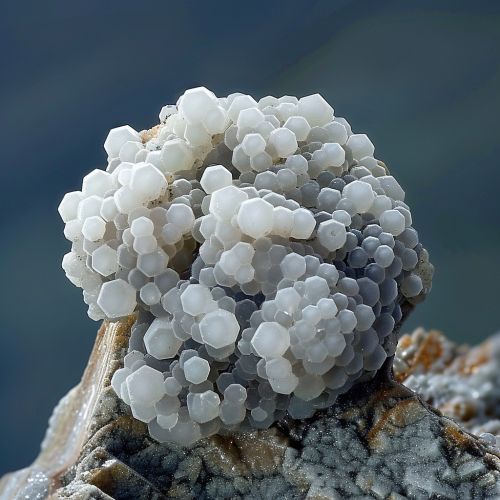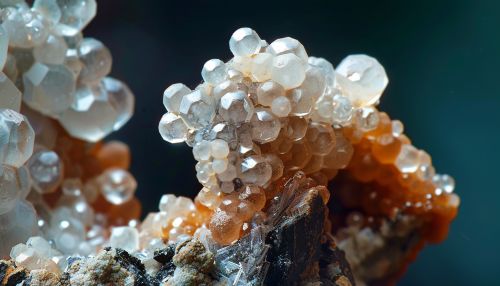Vaterite
Introduction
Vaterite is a mineral form of calcium carbonate (CaCO₃). It is one of the three common polymorphs of calcium carbonate, the others being calcite and aragonite. Vaterite is the least stable of the three polymorphs and is often found in a metastable state. It is named after the German mineralogist Heinrich Vater, who first described it in 1903.
Structure and Properties
Vaterite crystallizes in the hexagonal crystal system and typically forms small, spherical aggregates. Its crystal structure is less dense and more disordered compared to calcite and aragonite. The unit cell of vaterite contains six calcium ions, six carbonate ions, and six water molecules. The disordered nature of its structure contributes to its metastability and tendency to transform into calcite or aragonite over time.
Vaterite has a lower density (2.54 g/cm³) compared to calcite (2.71 g/cm³) and aragonite (2.93 g/cm³). Its refractive index ranges from 1.55 to 1.65, and it exhibits birefringence. Vaterite is typically colorless or white, although it can appear in various shades depending on impurities.


Occurrence and Formation
Vaterite is relatively rare in nature and is often found in association with other calcium carbonate minerals. It can form in a variety of environments, including freshwater and marine settings, as well as in biological systems. In nature, vaterite is often found in the shells of certain mollusks, the otoliths of fish, and the eggshells of some birds.
The formation of vaterite can occur through both abiotic and biotic processes. Abiotic formation typically involves the precipitation of calcium carbonate from supersaturated solutions under specific conditions of temperature, pH, and ionic strength. Biotic formation, on the other hand, is often mediated by organisms that produce vaterite as part of their biological processes.
Stability and Transformation
Vaterite is the least stable polymorph of calcium carbonate and readily transforms into calcite or aragonite under ambient conditions. This transformation can be triggered by changes in temperature, pressure, or the presence of water. The transformation process involves the dissolution of vaterite and the subsequent precipitation of calcite or aragonite.
The metastability of vaterite is a subject of significant interest in both geological and materials science research. Understanding the conditions that stabilize vaterite and the mechanisms of its transformation can provide insights into the diagenesis of carbonate sediments and the development of advanced materials.
Applications and Uses
Despite its instability, vaterite has several practical applications. In the field of biomineralization, vaterite is studied for its role in the formation of biological structures. It is also used in the synthesis of advanced materials, such as drug delivery systems and bioactive coatings. The unique properties of vaterite, such as its high surface area and porosity, make it suitable for these applications.
In the pharmaceutical industry, vaterite is explored as a carrier for controlled drug release. Its porous structure allows for the encapsulation of drugs, which can be released in a controlled manner. In the field of biomaterials, vaterite coatings are used to enhance the bioactivity of implants and promote bone regeneration.
Research and Future Directions
Research on vaterite continues to evolve, with a focus on understanding its formation, stability, and transformation. Advances in analytical techniques, such as X-ray diffraction and electron microscopy, have provided detailed insights into the crystal structure and properties of vaterite. These techniques have also enabled the study of vaterite at the nanoscale, revealing its potential for nanotechnology applications.
Future research aims to develop methods for stabilizing vaterite and controlling its transformation. This could lead to the development of new materials with tailored properties for specific applications. Additionally, understanding the role of vaterite in natural systems can provide insights into the processes of biomineralization and the diagenesis of carbonate sediments.
